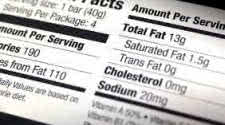Protein Bars - Understanding the Macronutrient Breakdown & Total Calories

Always Fully Understanding a Food Label for Proper Health Nutrition
Have you ever noticed that on many of the protein supplement bars In the market today, the macronutrient
breakdown on the label does not always equate to the total calorie count. Why is that?... Let's take a
closer look. All foods are made up of carbohydrates, fats and/or protein. If you total the calories from
each component, it is logical to expect those numbers to add up to the total calories. As you've
discovered, that isn't always the case. Many foods - and protein bars are among them - have as many as
10 to 20% of their calories unaccounted for on the label.
Virtually every low-carbohydrate bar on the market contains glycerol, a substance used to keep
high-protein bars moist so they don't turn to stone on the shelf. Glycerol (also known as glycerin) does
this by trapping water within the bar. The new fluffy soft bars are loaded with glycerol - 10-15 g per bar.
Although this substance is listed in the ingredients, it often either doesn't show up on the label's
nutritional information or is listed as a "noncarbohydrate." There's an ongoing debate about how glycerol
should be classified; that's the reason for confusing label information.
The Code of Federal Regulations (CFR) states that glycerol is a three-carbon sugar alcohol based on reduction
of glyceraldehyde. The CFR also states that because glycerol is neither a fat (it does not contain any fatty
acids) nor a protein (it does not have an amine group), it must be a carbohydrate by process of elimination.
However, the metabolic fate of glycerol depends on the metabolic situation within the body during the time
of absorption, so it doesn't always act as a carbohydrate.
Under the law, though, glycerin is supposed to be included in the total carbohydrate grams on the Supplement
Facts or Nutrition Facts panel. Nevertheless, many companies interpret the law more broadly and do not
include glycerol in the total carbohydrate calculation. While this sidesteps the law, it also makes the
product appear to have fewer carbohydrates. Many labels would therefore reflect a substantial increase in
carbohydrates if the macronutrient breakdown matched the calorie total.
Although the FDA may insist that glycerol be listed as a carbohydrate, that doesn't mean that eating your
favorite New-Age bar will add to your waistline. The body utilizes only a small portion of glycerol as
carbohydrate, so any calorie contribution due to its conversion to carbohydrate is relatively small.
Exactly how glycerol affects your metabolism is a function of your insulin level. If you're not limiting
carbs, glycerol is probably going to be used as a structural component. For example, glycerol can be used
in the membrane components phospholipids and triglycerides, having no immediate effect on energy metabolism
or stores. If, however, you are on a low carb diet, the glycerol contained in the New-Age bars may eventually
appear as carbohydrate, but it will have more of a timed-release effect on serum glucose. Glycerol is
therefore much less likely than regular carbs to elicit an increase in serum insulin. So, is it a
carbohydrate or not? In a bodybuilding context, probably not.